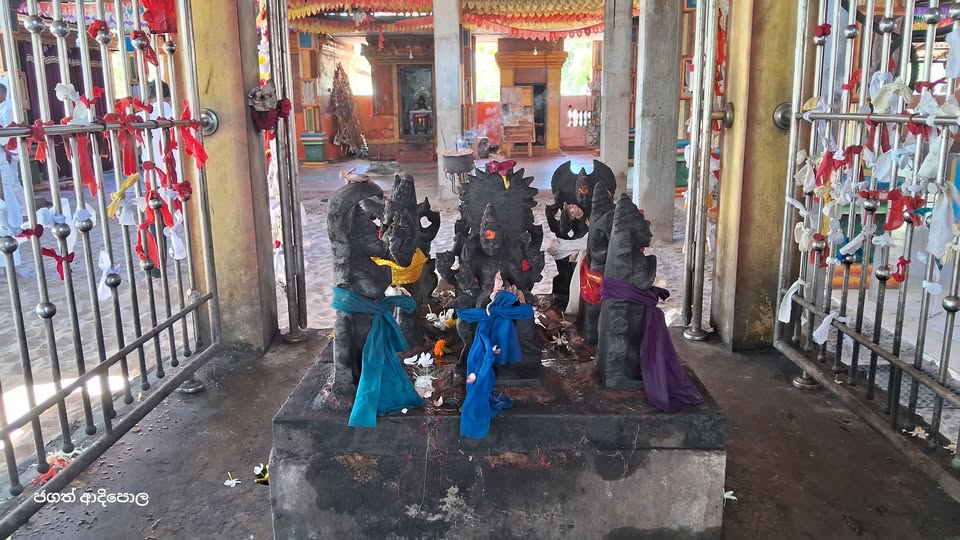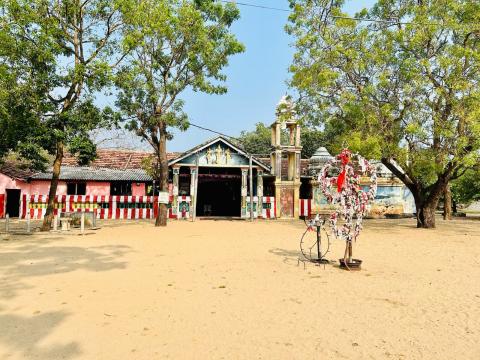Explore the Sacred Okanda Devalaya
Explora el Sagrado Okanda Devalaya – Una Puerta al Patrimonio Espiritual de Sri Lanka
Ubicado en la costa sureste de Sri Lanka, Okanda Devalaya es un templo lleno de leyenda y significado espiritual. Se cree que es el sitio donde el Dios Skanda (también conocido como Murugan) llegó por primera vez a Sri Lanka en un barco de oro, y este templo es un sitio de peregrinación vital para los devotos hindúes. Con su estilo arquitectónico único del sur de la India y su papel en la peregrinación anual ‘Pada Yathra’, Okanda Devalaya es un destino de visita obligada para aquellos que buscan explorar el rico patrimonio cultural y religioso de Sri Lanka.
¿Por qué visitar Okanda Devalaya?

Okanda Devalaya es más que un simple templo; es un lugar donde el mito, la historia y la espiritualidad convergen. La conexión del templo con el Festival Esala de Katharagama y su impresionante ubicación costera lo convierten en una experiencia única y enriquecedora para los visitantes. Ya seas un peregrino, un entusiasta de la historia o un viajero en busca de una visión espiritual, Okanda Devalaya ofrece algo verdaderamente especial.
La Leyenda de Okanda Devalaya
Según la creencia hindú, el Dios Skanda (Murugan) llegó a Sri Lanka en Okanda en un barco de oro, marcando el comienzo de su presencia divina en la isla. Este evento se conmemora en el Okanda Devalaya, que desde entonces se ha convertido en un sitio sagrado para los devotos. La arquitectura del templo refleja influencias del sur de la India, lo que añade a su significado cultural.
La Peregrinación Anual ‘Pada Yathra’

Uno de los eventos más significativos en Okanda Devalaya es la ‘Pada Yathra’, una peregrinación a pie de una semana de duración que tiene lugar anualmente. Devotos del sur de la India, así como de las costas norte y este de Sri Lanka, se reúnen en Okanda Devalaya para comenzar su viaje a través del Parque Nacional Yala hasta el Festival Esala de Katharagama. Esta peregrinación es una profunda expresión de fe y devoción, que atrae a miles de participantes cada año.
Qué Ver en Okanda Devalaya
- La Arquitectura del Templo
El templo actual está construido al estilo de un Kovil del sur de la India, con intrincadas tallas y colores vibrantes. Su diseño único lo distingue de otros templos en Sri Lanka. - El Entorno Costero
La ubicación del templo cerca de la costa ofrece impresionantes vistas del Océano Índico. El ambiente sereno se suma a la atmósfera espiritual del sitio. - Festivales Culturales y Religiosos
Si visitas durante la ‘Pada Yathra’ u otros festivales, presenciarás rituales vibrantes, procesiones y ceremonias que muestran la profunda devoción de los peregrinos.
Cómo Llegar a Okanda Devalaya
Okanda Devalaya se encuentra en la costa sureste de Sri Lanka, cerca de Pottuvil y Arugam Bay. Se puede acceder a través de la autopista A4, y el viaje ofrece vistas panorámicas de las llanuras orientales y la costa de la isla. El templo está aproximadamente a 6 horas en coche de Colombo.
Consejos para Visitar Okanda Devalaya
- Mejor Época para Visitar: El templo está abierto todo el año, pero visitar durante la ‘Pada Yathra’ (generalmente en julio o agosto) ofrece una experiencia cultural única.
- Qué Vestir: Se recomienda ropa modesta, ya que el templo es un lugar de importancia religiosa.
- Respeta las Costumbres Locales: Sé consciente de los rituales y prácticas de los devotos, especialmente durante los festivales.
- Tours Guiados: Considera contratar un guía local para aprender más sobre la historia y las leyendas del templo.
Planifica tu Visita con Sri Lanka Tour Help
En Sri Lanka Tour Help, nos especializamos en crear experiencias de viaje personalizadas que se adaptan a tus intereses. Ya sea que explores templos sagrados, participes en festivales culturales o te sumerjas en la belleza natural de Sri Lanka, podemos ayudarte a planificar el viaje perfecto a Okanda Devalaya y más allá. Contáctanos hoy mismo para comenzar tu viaje al corazón del patrimonio espiritual de Sri Lanka.
Okanda Devalaya es un destino que ofrece una mezcla única de espiritualidad, historia y belleza natural. Agrega este sitio sagrado a tu itinerario de Sri Lanka y experimenta la magia de sus leyendas y tradiciones. Deja que la energía divina de Okanda Devalaya te inspire y eleve mientras exploras este notable rincón de Sri Lanka.
Crédito de la foto:
Página de Facebook de Okanda Dewala
Para información sobre 2025: පාද යාත්රා 2025 - Pada Yatra - Grupo Oficial de Facebook



.png)
Comentarios
No hay comentarios todavía